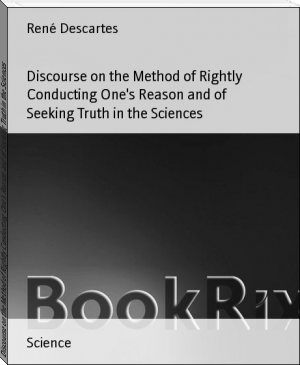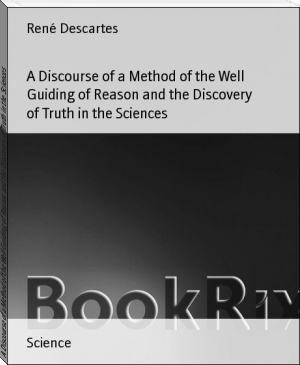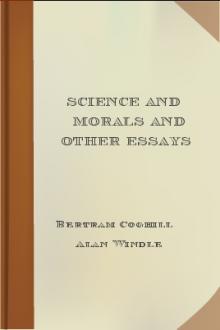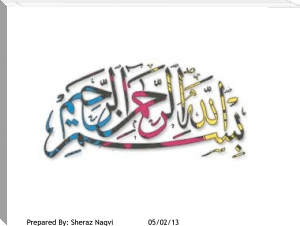Discourse on the Method of Rightly Conducting One's Reason and of Seeking Truth in the Sciences by René Descartes (reading comprehension books TXT) 📕

- Author: René Descartes
Book online «Discourse on the Method of Rightly Conducting One's Reason and of Seeking Truth in the Sciences by René Descartes (reading comprehension books TXT) 📕». Author René Descartes
the lungs from returning to this cavity; and, in like manner, two others at the mouth of the venous artery, which allow the blood from the lungs to flow into the left cavity of the heart, but preclude its return; and three at the mouth of the great artery, which suffer the blood to flow from the heart, but prevent its reflux. Nor do we need to seek any other reason for the number of these pellicles beyond this that the orifice of the venous artery being of an oval shape from the nature of its situation, can be adequately closed with two, whereas the others being round are more conveniently closed with three. Besides, I wish such persons to observe that the grand artery and the arterial vein are of much harder and firmer texture than the venous artery and the hollow vein; and that the two last expand before entering the heart, and there form, as it were, two pouches denominated the auricles of the heart, which are composed of a substance similar to that of the heart itself; and that there is always more warmth in the heart than in any other part of the body--and finally, that this heat is capable of causing any drop of blood that passes into the cavities rapidly to expand and dilate, just as all liquors do when allowed to fall drop by drop into a highly heated vessel.
For, after these things, it is not necessary for me to say anything more with a view to explain the motion of the heart, except that when its cavities are not full of blood, into these the blood of necessity flows,--from the hollow vein into the right, and from the venous artery into the left; because these two vessels are always full of blood, and their orifices, which are turned towards the heart, cannot then be closed. But as soon as two drops of blood have thus passed, one into each of the cavities, these drops which cannot but be very large, because the orifices through which they pass are wide, and the vessels from which they come full of blood, are immediately rarefied, and dilated by the heat they meet with. In this way they cause the whole heart to expand, and at the same time press home and shut the five small valves that are at the entrances of the two vessels from which they flow, and thus prevent any more blood from coming down into the heart, and becoming more and more rarefied, they push open the six small valves that are in the orifices of the other two vessels, through which they pass out, causing in this way all the branches of the arterial vein and of the grand artery to expand almost simultaneously with the heart which immediately thereafter begins to contract, as do also the arteries, because the blood that has entered them has cooled, and the six small valves close, and the five of the hollow vein and of the venous artery open anew and allow a passage to other two drops of blood, which cause the heart and the arteries again to expand as before. And, because the blood which thus enters into the heart passes through these two pouches called auricles, it thence happens that their motion is the contrary of that of the heart, and that when it expands they contract. But lest those who are ignorant of the force of mathematical demonstrations and who are not accustomed to distinguish true reasons from mere verisimilitudes, should venture, without examination, to deny what has been said, I wish it to be considered that the motion which I have now explained follows as necessarily from the very arrangement of the parts, which may be observed in the heart by the eye alone, and from the heat which may be felt with the fingers, and from the nature of the blood as learned from experience, as does the motion of a clock from the power, the situation, and shape of its counterweights and wheels.
But if it be asked how it happens that the blood in the veins, flowing in this way continually into the heart, is not exhausted, and why the arteries do not become too full, since all the blood which passes through the heart flows into them, I need only mention in reply what has been written by a physician of England, who has the honor of having broken the ice on this subject, and of having been the first to teach that there are many small passages at the extremities of the arteries, through which the blood received by them from the heart passes into the small branches of the veins, whence it again returns to the heart; so that its course amounts precisely to a perpetual circulation. Of this we have abundant proof in the ordinary experience of surgeons, who, by binding the arm with a tie of moderate straitness above the part where they open the vein, cause the blood to flow more copiously than it would have done without any ligature; whereas quite the contrary would happen were they to bind it below; that is, between the hand and the opening, or were to make the ligature above the opening very tight. For it is manifest that the tie, moderately straightened, while adequate to hinder the blood already in the arm from returning towards the heart by the veins, cannot on that account prevent new blood from coming forward through the arteries, because these are situated below the veins, and their coverings, from their greater consistency, are more difficult to compress; and also that the blood which comes from the heart tends to pass through them to the hand with greater force than it does to return from the hand to the heart through the veins. And since the latter current escapes from the arm by the opening made in one of the veins, there must of necessity be certain passages below the ligature, that is, towards the extremities of the arm through which it can come thither from the arteries. This physician likewise abundantly establishes what he has advanced respecting the motion of the blood, from the existence of certain pellicles, so disposed in various places along the course of the veins, in the manner of small valves, as not to permit the blood to pass from the middle of the body towards the extremities, but only to return from the extremities to the heart; and farther, from experience which shows that all the blood which is in the body may flow out of it in a very short time through a single artery that has been cut, even although this had been closely tied in the immediate neighborhood of the heart and cut between the heart and the ligature, so as to prevent the supposition that the blood flowing out of it could come from any other quarter than the heart.
But there are many other circumstances which evince that what I have alleged is the true cause of the motion of the blood: thus, in the first place, the difference that is observed between the blood which flows from the veins, and that from the arteries, can only arise from this, that being rarefied, and, as it were, distilled by passing through the heart, it is thinner, and more vivid, and warmer immediately after leaving the heart, in other words, when in the arteries, than it was a short time before passing into either, in other words, when it was in the veins; and if attention be given, it will be found that this difference is very marked only in the neighborhood of the heart; and is not so evident in parts more remote from it. In the next place, the consistency of the coats of which the arterial vein and the great artery are composed, sufficiently shows that the blood is impelled against them with more force than against the veins. And why should the left cavity of the heart and the great artery be wider and larger than the right cavity and the arterial vein, were it not that the blood of the venous artery, having only been in the lungs after it has passed through the heart, is thinner, and rarefies more readily, and in a higher degree, than the blood which proceeds immediately from the hollow vein? And what can physicians conjecture from feeling the pulse unless they know that according as the blood changes its nature it can be rarefied by the warmth of the heart, in a higher or lower degree, and more or less quickly than before? And if it be inquired how this heat is communicated to the other members, must it not be admitted that this is effected by means of the blood, which, passing through the heart, is there heated anew, and thence diffused over all the body? Whence it happens, that if the blood be withdrawn from any part, the heat is likewise withdrawn by the same means; and although the heart were as-hot as glowing iron, it would not be capable of warming the feet and hands as at present, unless it continually sent thither new blood. We likewise perceive from this, that the true use of respiration is to bring sufficient fresh air into the lungs, to cause the blood which flows into them from the right ventricle of the heart, where it has been rarefied and, as it were, changed into vapors, to become thick, and to convert it anew into blood, before it flows into the left cavity, without which process it would be unfit for the nourishment of the fire that is there. This receives confirmation from the circumstance, that it is observed of animals destitute of lungs that they have also but one cavity in the heart, and that in children who cannot use them while in the womb, there is a hole through which the blood flows from the hollow vein into the left cavity of the heart, and a tube through which it passes from the arterial vein into the grand artery without passing through the lung. In the next place, how could digestion be carried on in the stomach unless the heart communicated heat to it through the arteries, and along with this certain of the more fluid parts of the blood, which assist in the dissolution of the food that has been taken in? Is not also the operation which converts the juice of food into blood easily comprehended, when it is considered that it is distilled by passing and repassing through the heart perhaps more than one or two hundred times in a day? And what more need be adduced to explain nutrition, and the production of the different humors of the body, beyond saying, that the force with which the blood, in being rarefied, passes from the heart towards the extremities of the arteries, causes certain of its parts to remain in the members at which they arrive, and there occupy the place of some others expelled by them; and that according to the situation, shape, or smallness of the pores with which they meet, some rather than others flow into certain parts, in the same way that some sieves are observed to act, which, by being variously perforated, serve to separate different species of grain? And, in the last place, what above all is here worthy of observation, is the generation of the animal spirits, which are like a very subtle wind, or rather a very pure and vivid flame which, continually ascending in great abundance from the heart to the brain, thence penetrates through the nerves into the muscles, and gives motion to all the members; so that to account for other
For, after these things, it is not necessary for me to say anything more with a view to explain the motion of the heart, except that when its cavities are not full of blood, into these the blood of necessity flows,--from the hollow vein into the right, and from the venous artery into the left; because these two vessels are always full of blood, and their orifices, which are turned towards the heart, cannot then be closed. But as soon as two drops of blood have thus passed, one into each of the cavities, these drops which cannot but be very large, because the orifices through which they pass are wide, and the vessels from which they come full of blood, are immediately rarefied, and dilated by the heat they meet with. In this way they cause the whole heart to expand, and at the same time press home and shut the five small valves that are at the entrances of the two vessels from which they flow, and thus prevent any more blood from coming down into the heart, and becoming more and more rarefied, they push open the six small valves that are in the orifices of the other two vessels, through which they pass out, causing in this way all the branches of the arterial vein and of the grand artery to expand almost simultaneously with the heart which immediately thereafter begins to contract, as do also the arteries, because the blood that has entered them has cooled, and the six small valves close, and the five of the hollow vein and of the venous artery open anew and allow a passage to other two drops of blood, which cause the heart and the arteries again to expand as before. And, because the blood which thus enters into the heart passes through these two pouches called auricles, it thence happens that their motion is the contrary of that of the heart, and that when it expands they contract. But lest those who are ignorant of the force of mathematical demonstrations and who are not accustomed to distinguish true reasons from mere verisimilitudes, should venture, without examination, to deny what has been said, I wish it to be considered that the motion which I have now explained follows as necessarily from the very arrangement of the parts, which may be observed in the heart by the eye alone, and from the heat which may be felt with the fingers, and from the nature of the blood as learned from experience, as does the motion of a clock from the power, the situation, and shape of its counterweights and wheels.
But if it be asked how it happens that the blood in the veins, flowing in this way continually into the heart, is not exhausted, and why the arteries do not become too full, since all the blood which passes through the heart flows into them, I need only mention in reply what has been written by a physician of England, who has the honor of having broken the ice on this subject, and of having been the first to teach that there are many small passages at the extremities of the arteries, through which the blood received by them from the heart passes into the small branches of the veins, whence it again returns to the heart; so that its course amounts precisely to a perpetual circulation. Of this we have abundant proof in the ordinary experience of surgeons, who, by binding the arm with a tie of moderate straitness above the part where they open the vein, cause the blood to flow more copiously than it would have done without any ligature; whereas quite the contrary would happen were they to bind it below; that is, between the hand and the opening, or were to make the ligature above the opening very tight. For it is manifest that the tie, moderately straightened, while adequate to hinder the blood already in the arm from returning towards the heart by the veins, cannot on that account prevent new blood from coming forward through the arteries, because these are situated below the veins, and their coverings, from their greater consistency, are more difficult to compress; and also that the blood which comes from the heart tends to pass through them to the hand with greater force than it does to return from the hand to the heart through the veins. And since the latter current escapes from the arm by the opening made in one of the veins, there must of necessity be certain passages below the ligature, that is, towards the extremities of the arm through which it can come thither from the arteries. This physician likewise abundantly establishes what he has advanced respecting the motion of the blood, from the existence of certain pellicles, so disposed in various places along the course of the veins, in the manner of small valves, as not to permit the blood to pass from the middle of the body towards the extremities, but only to return from the extremities to the heart; and farther, from experience which shows that all the blood which is in the body may flow out of it in a very short time through a single artery that has been cut, even although this had been closely tied in the immediate neighborhood of the heart and cut between the heart and the ligature, so as to prevent the supposition that the blood flowing out of it could come from any other quarter than the heart.
But there are many other circumstances which evince that what I have alleged is the true cause of the motion of the blood: thus, in the first place, the difference that is observed between the blood which flows from the veins, and that from the arteries, can only arise from this, that being rarefied, and, as it were, distilled by passing through the heart, it is thinner, and more vivid, and warmer immediately after leaving the heart, in other words, when in the arteries, than it was a short time before passing into either, in other words, when it was in the veins; and if attention be given, it will be found that this difference is very marked only in the neighborhood of the heart; and is not so evident in parts more remote from it. In the next place, the consistency of the coats of which the arterial vein and the great artery are composed, sufficiently shows that the blood is impelled against them with more force than against the veins. And why should the left cavity of the heart and the great artery be wider and larger than the right cavity and the arterial vein, were it not that the blood of the venous artery, having only been in the lungs after it has passed through the heart, is thinner, and rarefies more readily, and in a higher degree, than the blood which proceeds immediately from the hollow vein? And what can physicians conjecture from feeling the pulse unless they know that according as the blood changes its nature it can be rarefied by the warmth of the heart, in a higher or lower degree, and more or less quickly than before? And if it be inquired how this heat is communicated to the other members, must it not be admitted that this is effected by means of the blood, which, passing through the heart, is there heated anew, and thence diffused over all the body? Whence it happens, that if the blood be withdrawn from any part, the heat is likewise withdrawn by the same means; and although the heart were as-hot as glowing iron, it would not be capable of warming the feet and hands as at present, unless it continually sent thither new blood. We likewise perceive from this, that the true use of respiration is to bring sufficient fresh air into the lungs, to cause the blood which flows into them from the right ventricle of the heart, where it has been rarefied and, as it were, changed into vapors, to become thick, and to convert it anew into blood, before it flows into the left cavity, without which process it would be unfit for the nourishment of the fire that is there. This receives confirmation from the circumstance, that it is observed of animals destitute of lungs that they have also but one cavity in the heart, and that in children who cannot use them while in the womb, there is a hole through which the blood flows from the hollow vein into the left cavity of the heart, and a tube through which it passes from the arterial vein into the grand artery without passing through the lung. In the next place, how could digestion be carried on in the stomach unless the heart communicated heat to it through the arteries, and along with this certain of the more fluid parts of the blood, which assist in the dissolution of the food that has been taken in? Is not also the operation which converts the juice of food into blood easily comprehended, when it is considered that it is distilled by passing and repassing through the heart perhaps more than one or two hundred times in a day? And what more need be adduced to explain nutrition, and the production of the different humors of the body, beyond saying, that the force with which the blood, in being rarefied, passes from the heart towards the extremities of the arteries, causes certain of its parts to remain in the members at which they arrive, and there occupy the place of some others expelled by them; and that according to the situation, shape, or smallness of the pores with which they meet, some rather than others flow into certain parts, in the same way that some sieves are observed to act, which, by being variously perforated, serve to separate different species of grain? And, in the last place, what above all is here worthy of observation, is the generation of the animal spirits, which are like a very subtle wind, or rather a very pure and vivid flame which, continually ascending in great abundance from the heart to the brain, thence penetrates through the nerves into the muscles, and gives motion to all the members; so that to account for other
Free e-book «Discourse on the Method of Rightly Conducting One's Reason and of Seeking Truth in the Sciences by René Descartes (reading comprehension books TXT) 📕» - read online now
Similar e-books:





Comments (0)